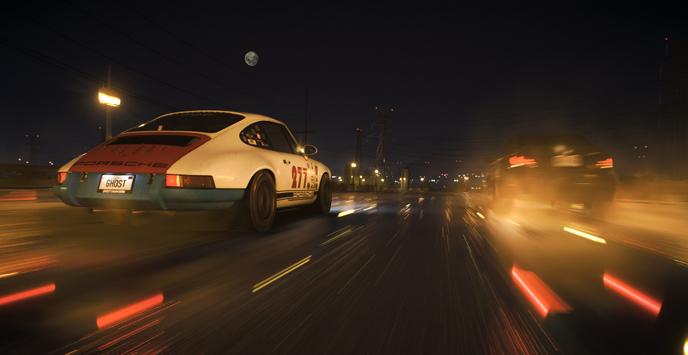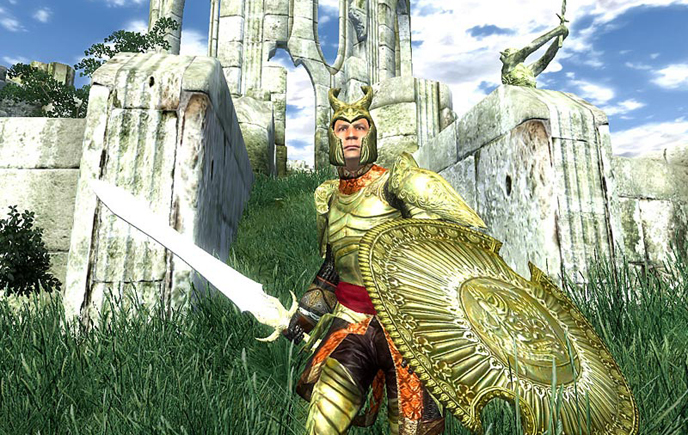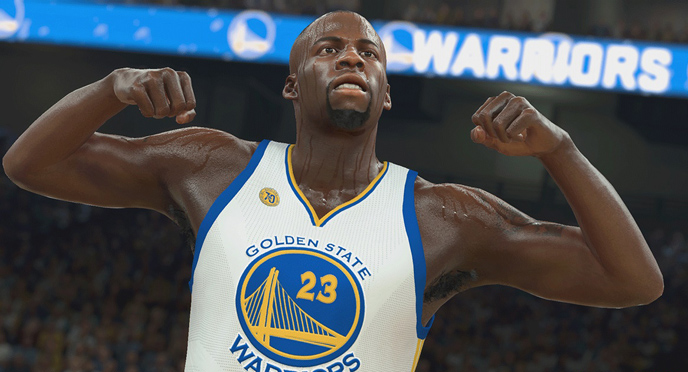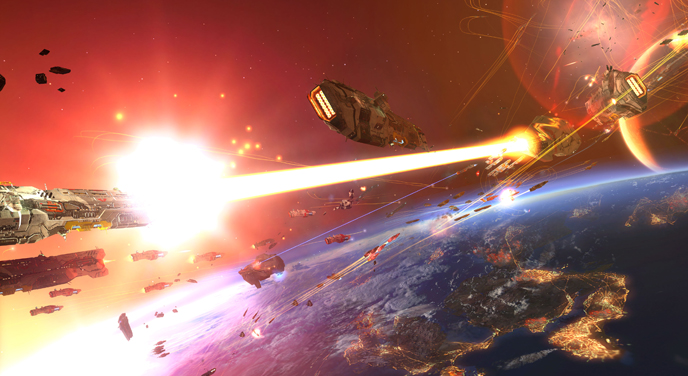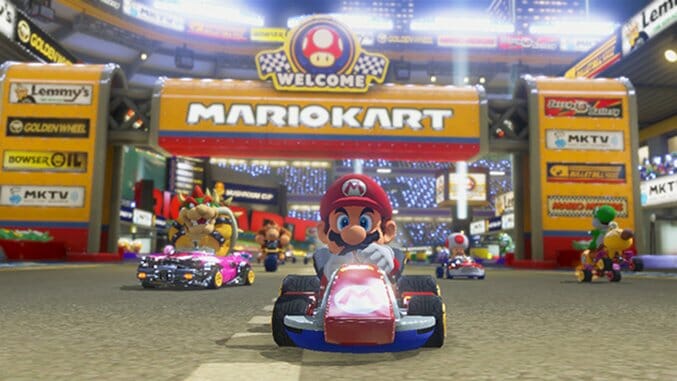
Picture it: you’re racing through the cobblestone streets of downtown Paris, driving with the flawless precision of The Stig from Top Gear. You’re miles ahead of the competition. You come to the Arc de Triomphe and drift expertly around its base. A smirk crests your lips, only to die as you catch a glint of metal in your rear-view mirror. 2nd place is right behind you, with 3rd and 4th trailing a few lengths back. Where the heck did they come from? That should be impossible, right?
Videogames, though, eat the impossible for breakfast. Messing with the physics of a race is not only trivial, it’s common enough to have earned itself a name: rubber banding. As the name suggests, this phenomenon mimics the behavior of elastic, artificially speeding up competitors at the back of the pack and slowing down those at the front. By drawing the field closer together, rubber banding purports to heighten the excitement of a race, preventing long, uneventful leads and foregone conclusions. In practice, though, it serves only to undermine the very spirit of competition.
Of the many games that resort to rubber banding, the following five are the most diabolical. If a fair test of skill is what you’re after, these are not the games you’re looking for.
Mario Kart
No series better exemplifies the hostility of rubber banding than Mario Kart. Anyone who’s been hit by a Blue Shell just as they’re about to cross the finish line knows how frustratingly cheap the kart racer can be. Watching helplessly as 2nd place cruises on by and steals your win is devastating, especially when there’s nothing you could have done to prevent it. The Blue Shell cares little for your silly notions of fairness; it seeks only chaos.
From its first appearance in Mario Kart 64, the notorious shell has rewarded skillful racing with naught but misery and despair, homing in on the race leader with the single-minded determination of a ravenous hawk. A ravenous explosive hawk, ever since Mario Kart: Double Dash. Along with other powerful items like the Golden Mushroom and Lightning, the Blue Shell drops far more frequently for racers at the back of the pack than those at the front, ostensibly giving them a chance to catch up and make the race more ‘exciting.’ In truth, this bias simply encourages us to drive slower in order to get the best items, saving them for the final stretch and leveraging their chaos for our own come-from-behind victory.
While practical, this approach fosters a dangerous mindset. By encouraging us to take the path of least resistance, Mario Kart’s rubber banding appeals to our slacker side, the part of us that wants to coast through life on as little effort as possible. Like the welfare cheats who intentionally flub job interviews in order to preserve their lazy lifestyles, we are compelled to drive poorly to set ourselves up for a cheap win. Driving fast would only make it easier to lose, demanding greater effort for no appreciable gain, and all in service of the exact same outcome. The message is clear: why work for something if you don’t have to?
When this mentality is not only permitted but encouraged, it undermines the very foundation on which our society has flourished. Trying your best is not just something we preach to our children; constantly pushing our limits is what has elevated our species from primitive cave-dwellers to a globally-connected intelligence capable of bending the world to our whim. Without the drive to better both ourselves and our species as a whole, we’d still be swinging from trees and flinging poop at each other.
Need for Speed
Rubber banding isn’t confined to kart racers. In its original state, 2015’s Need for Speed leaned heavily on the elastic phenomenon, leading to bizarre scenarios where you’d be rocketing along in your sleek Lamborghini, only to see a crummy little Volkswagen Golf boost right past you, its engine as jacked up as the game’s bombastic characters. The reverse held true, too: some races would seem impossible from the outset, with first place always one corner ahead of you no matter how well you drove. As the finish line neared, however, they would inexplicably slow down, paving the way for your last-second victory. Exhilarating? Not really. A win doesn’t feel like a win when it’s handed to you on a silver platter.
Need for Speed’s artificial victories echoed a refrain that’s becoming increasingly common lately: the notion that everyone is special, that we are all remarkable in some meaningful way. As a tool of positive thinking, such a claim helps remind us that we all have value, even if we fail an exam, get passed over for a job, or have the love of our life dump us for someone ‘better’. In some cases, though, the notion is taken too far, used as a salve for the slightest of bruised egos. It becomes a crutch for over-protective parents too afraid to let their kids know the pain of defeat, for a society too scared to let anyone go home empty-handed. And so we get un-birthday presents to ensure no one feels excluded, participation awards for just showing up, A grades for being only slightly better than the average. In turn, because everyone is special, no one is.
Rubber banding reflects this attitude at its most extreme. Victory is treated as a universal right, divorced from skill and effort and handed out so freely as to lose all meaning. Forced uniformity erases our racing ability, trapping us in a hamster wheel of impotence and artificial equality. Cynically, one might draw parallels with the tenets of communism, the abolition of class separation and the disregard for individual contributions. And, just like communism, the theory seems sound until it’s put into practice.
Fortunately, Need for Speed developer Ghost Games received so many complaints about what it dubbed ‘AI catch-up’ that community manager Ben Walke came out and addressed the issue, promising that the studio was taking to heart player feedback and changing the AI behavior to ‘improve [the] overall experience’. The rubber banding was eventually patched out, and the game was markedly better for it.
The Elder Scrolls IV: Oblivion
Racing games aren’t the only culprits when it comes to rubber banding. Leveling systems in RPGs are equally ripe for abuse, punishing excellence with an endless cycle of stronger enemies and stiffer challenges. The Elder Scrolls IV: Oblivion is notorious in this regard. As you level up your anthropomorphic lizard or magical cat person, the province of Cyrodiil levels up with you. Petty bandits trade in their filthy rags and blunt knives for gleaming cuirasses and razor-sharp swords; feeble mudcrabs suddenly become fearsome monsters capable of killing your hardened warrior in just a few hits. Allied NPCs, meanwhile, do not scale along with you and your enemies, making any quest that involves AI companions far more difficult the stronger you are. In defiance of long-standing RPG tradition, the more you grind, the tougher Oblivion gets.
Bethesda copped a lot of flak for Oblivion’s leveling system, and for good reason. If we’re to strive for greatness, we need to know our efforts will be rewarded, or else why should we bother? Consider how the technology world deals with this dilemma. Giving away the inner workings of your revolutionary invention might be nice and altruistic, but it won’t pay the R&D bills. Never sharing your secrets, though, denies others the chance to improve upon your design, depriving our collective intelligence of the fuel to move it forward. To balance the two opposing interests, we developed the patent process, granting applicants the exclusive right to make and sell their invention for a set period after which anyone can build and iterate on it as they see fit. While in practice the patent system can be flawed, the theory of motivation behind it is solid.
The same cannot be said for rubber banding. The incentive to level up in Oblivion is outweighed by the advantage doing so confers upon your enemies; the stronger you are, the stronger they are. Individually, your best option is to never level at all, condemning both yourself and Cyrodiil to evolutionary stasis. For any society founded on cooperation, this attitude is disastrous, anathema to the spirit of mutual improvement at the heart of civilization. When individual excellence is robbed of its reward, the drive to better ourselves withers and dies—and the progress of our species goes along with it.
NBA 2K
The curse of rubber banding goes beyond player-vs-AI competition. In recent installments of the NBA 2K franchise, matches between two human players are frequently plagued by artificial homogeneity, the very laws of physics bent in service of manufactured drama. If one player has a comfortable lead going into the fourth quarter, their AI teammates will inexplicably start making mistakes and missing easy shots to give the other player a chance to catch up. Meanwhile, the other player’s teammates will sink impossible buckets and use the force to teleport the ball into their hands. Realism and consistency get tossed out the window in favor of the clutch victory.
The method behind this madness isn’t entirely flawed. By making the threat of defeat inescapable, NBA 2K’s rubber banding does foment tension—and, theoretically, excitement. At the same time, however, it effectively renders moot everything prior to the final quarter; whether you’ve been leading or losing up to that point, your chances of winning will be effectively identical. The journey itself becomes meaningless, the destination all that matters. It’s a decidedly myopic perspective, one that places more stock in a few minutes of frenzied fortune than a history of consistent, stable performance. Like the volatile oscillations of the share market, such short-sightedness sees patterns that aren’t really there, assuming that excellence is as perfectly scalable as a fractal honeycomb. One need only look at the brief surge and swift decline Nintendo stock experienced in the wake of Pokemon GO to see how misleading that approach can be.
Homeworld
Some games are so infatuated with rubber banding that they eschew difficulty levels entirely, relying instead on a one-size-fits-all solution regardless of player skill. The Homeworld series of space strategy games is infamous for this. In their single-player campaigns, you maintain the same fleet of ships from mission to mission, your losses carrying over from one to the next. In theory, this approach lends the story a sense of permanence and danger absent in a string of stand-alone missions; scrape through one battle with just a handful of ships left, and you’ll start the next one feeling appropriately underpowered. In practice, however, the persistence clashes with the game’s dynamic difficulty scaling, which adjusts the strength of the enemy’s forces based on the size of your own fleet at the start of every mission. The better you do, the tougher the enemy becomes.
In some missions, this can lead to enemy forces so powerful, they might as well be invincible. To compensate, players developed a strategy where they sell off the majority of their fleet at the end of every mission so that the next one would scale to easy. Once the new mission starts, they simply buy back the ships and trounce the enemy with overwhelming force. It’s an effective strategy, but it raises a troubling question: if the only way to win is to game the system, what’s the point of playing at all?
This is the existential quandary lying at the heart of rubber banding. Why do we compete? What are we fighting for? The roar of the crowd and the praise of our peers? The glory of looking down from the top of the leaderboard? Or is it for the simple satisfaction of personal triumph?
The answer lies in our actions. If we give our all against a field of rubber-banding opponents, even when doing so will have little impact on our chance of victory, we reveal of ourselves a strong self-concept, our self-esteem built on a sturdy foundation of personal reflection. While we might be able to win by cheesing systems or coasting along until the last lap, doing so would lead to feelings of guilt and cognitive dissonance, threatening our perception of ourselves as hard, studious workers. Deliberately underperforming would contradict our self-image and leave us in a state of existential discomfort, so instead we truck on in spite of the rubber banding and seek satisfaction from inside, rather than out. The leaderboard might not reflect it, but so long as we know we did our best, we can be content.
On the other hand, if we decide that winning is the only reason to compete, we confess to an identity mired in the superficial. The gold trophy, the #1 spot, the bragging rights: we build our self-esteem atop a rickety framework of extrinsic approval. By committing ourselves only when doing so will be witnessed and acknowledged by others, we reveal a fragile self-concept reliant on third-party succor to survive. Like rubber banding itself, our worth is only skin deep.
Rubber banding is hostile game design. It punishes drive and rewards stagnation. We are compelled to hold back, to only give of ourselves the bare minimum since any more will go unrecognized. Wins feel unearned, losses unpreventable. The illusion of competition replaces the real thing, our diversity of skill expunged in favor of facile ‘equality’. Just as a utopia built on forced conformity inevitably crumbles, a race steeped in rubber banding is destined to end in disappointment.
